A clean prep table is essential to prevent contamination. A table that has been used for preparing food needs to be sanitized in order to avoid contamination. During this COVID-19 situation it’s very much important to know, what is the proper way to sanitize a table that has been used for preparing food? There are three very important reasons for this:
- The table can be a breeding ground for bacteria.
- If the table is not sanitized, it can contaminate other surfaces like the floor or counters.
- Bacteria on the table can cause illness, so it is important to make sure that you are not putting anyone at risk.
During this pandemic we should sanitize all our daily need, even from money to food. Sanitizing a table should be done after every use and before using it again. This article will provide you with a list of items that you can use to clean your prep table and the steps on how to do it.
When should food preparation surfaces be cleaned and sanitized?
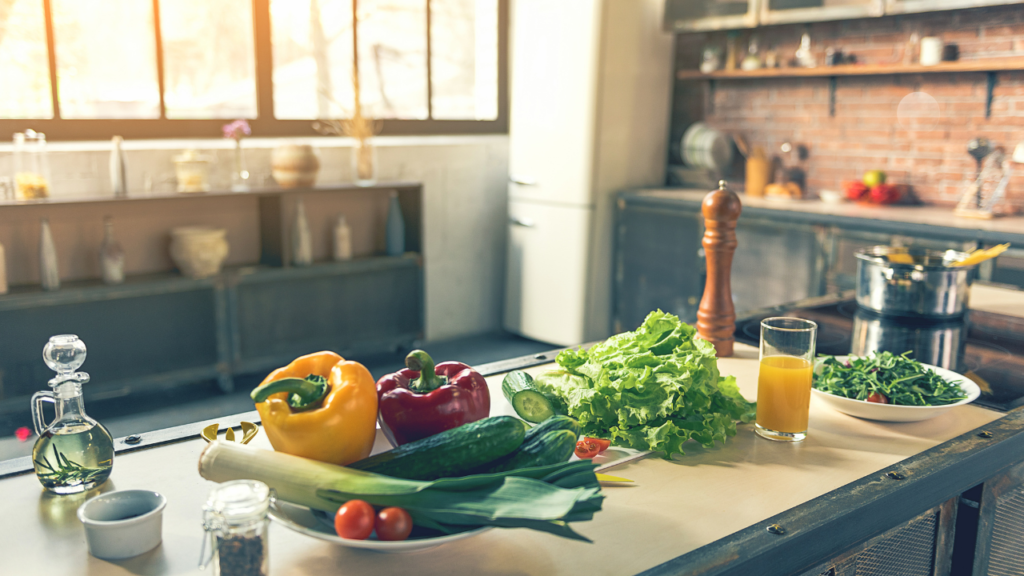
To stop the growth and spread of dangerous bacteria and other microbes that can lead to foodborne diseases, food preparation surfaces should be cleaned and sanitized often.
Surfaces used for food preparation should generally be cleaned and sanitized:
Before use: Any surface used for food preparation should be completely cleaned and sterilized before use to guarantee that all dirt and bacteria have been eliminated.
After use: To stop the growth of bacteria or other hazardous microorganisms, a food preparation surface should be wiped and sanitized right afterwards.
When switching between different types of foods: The food preparation surface should always be cleaned and sanitized before transitioning between different types of food preparation in order to avoid cross-contamination.
When contamination or visible dirt are present on the surface: Immediately clean and sterilize the food preparation surface if you see any obvious dirt, trash, or contamination there.
It’s crucial to remember that various food preparation surfaces could call for various cleaning and sanitizing procedures. For instance, cleaning stainless steel surfaces and wooden cutting boards may require various approaches. Make careful to clean and sanitize each type of food preparation surface in accordance with the manufacturer’s instructions.
What are the necessities for sanitizing a table that has been used for preparing food?
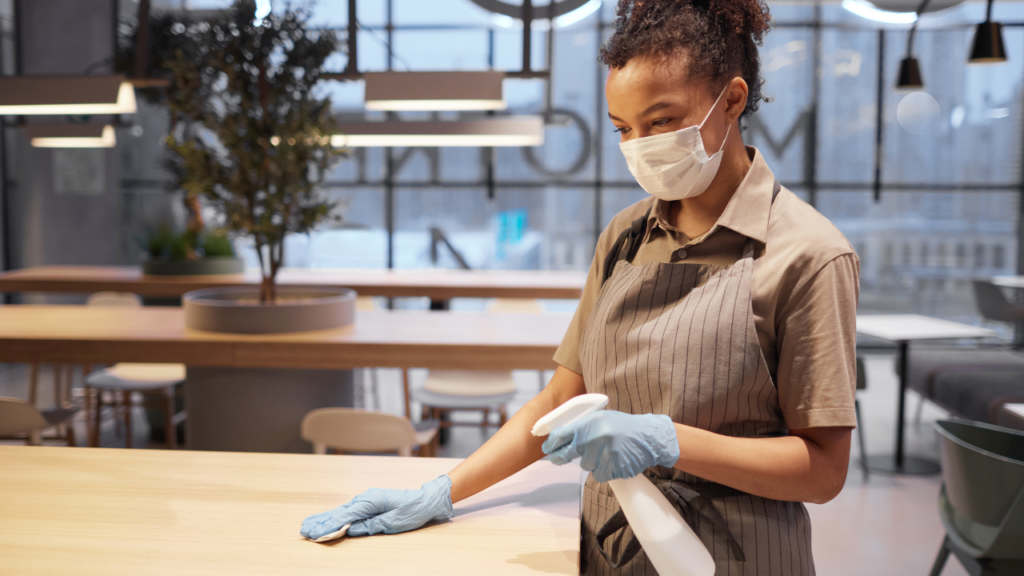
Despite the fact that food preparation can be a dangerous process. It doesn’t mean that you can’t enjoy your favorite meal. However, there are certain necessities that you need in order to sanitize a table. If you fail to take the necessary precautions, you could expose yourself to a lot of health risks. Here are the necessary precautions that you need to take in order to sanitize a table that has been used for preparing food.
Sanitizing a a table that has been used for preparing food is not as complicated as it may seem at first glance. In order to do so, one must first apply a disinfectant to it and wipe it down with a wet cloth. Then, one must dry the surface of the table off in order to ensure that no bacteria remains on its surface. Finally, the table should be dried with a clean towel or paper towel.
In order to sanitize a table, you will need to use a sanitizer that is approved for the food that was prepared. The sanitizer should be applied to a clean surface that is not used for food preparation. After the sanitizer has been applied, it should remain on the surface for at least 20 seconds before it is wiped away. If a surface has been used in a commercial kitchen, it should be thoroughly cleaned before it is used again. For example, if the surface is a cutting board, it should be soaked in a solution of hot water and bleach for at least five minutes.
What Is the Best Way To Sanitize A Table That Has Been Used For Preparing Food?
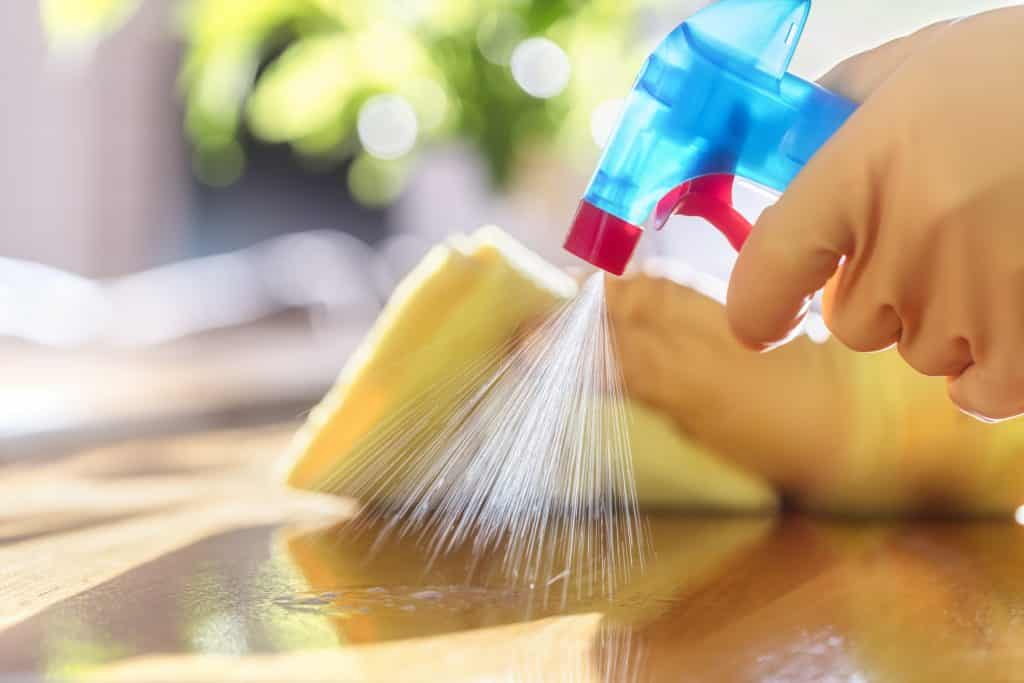
When you are using a table that is used for cooking and preparing food, you want to make sure that there is no bacteria on the table. It is also important to make sure that there is nothing on the table that could be a source of bacteria. This article will provide you with the best way to clean and sanitize a table that has been used for preparing food.
Method 1: Using Bleach Solution
Sanitizing tables is a vital step in preparing food. The reason for this is because the table can be a breeding ground for bacteria and other contaminants that can contaminate the food. There are many ways to sanitize tables, but one of the most common methods is to use bleach.
You will need: - A bleach germicidal cleaner - Cleaning cloths - A clean sponge or dishcloth
This solution should be sprayed on the table before it’s scrubbed down with a disinfectant scrubber. This process should be repeated until all visible signs of bacteria are gone from the surface of the table.
Method 2: Using A Disinfectant Spray
The first step to sanitizing a table is to make sure that the table is clean.
The best way to do this is to use a wet cloth and wipe down the surface of the table.
Next, use another wet cloth or towel and wipe down any areas where food may have spilled. Such as on the edge of the table or on chairs.
Then, take a dry towel or cloth and wipe off any excess water from all surfaces of the table.
Lastly, use a disinfectant spray (or other disinfectant) on all surfaces of the table in order to kill any bacteria left behind by food preparation.
Here are our recommendations for the best Sanitizers for a table that you can use for preparing food:
1. HoMedics Ozone Clean 3-in-1 Multipurpose Cleaner (click here to view) 2. PURELL Foodservice Surface Sanitizer, Fragrance Free (click here to view) 3. Ozone Clean Chemical-Free Disinfectant Spray, 3-in-1 Multipurpose Surface Cleaner Sanitizer (click here to view) 4. PURELL Foodservice Surface Sanitizer Spray, Fragrance Free (click here to view) 5. Mrs. Meyer's Clean Day Multi-Surface Cleaner Spray (click here to view) 6. CloroxPro Anywhere Hard Surface Sanitizing Spray (click here to view) 7. Puracy Multi-Surface Cleaner, Organic Lemongrass, Streak-Free Natural All Purpose Cleaner for Kitchens (click here to view)
Why must prep tables be cleaned and sanitized between uses?
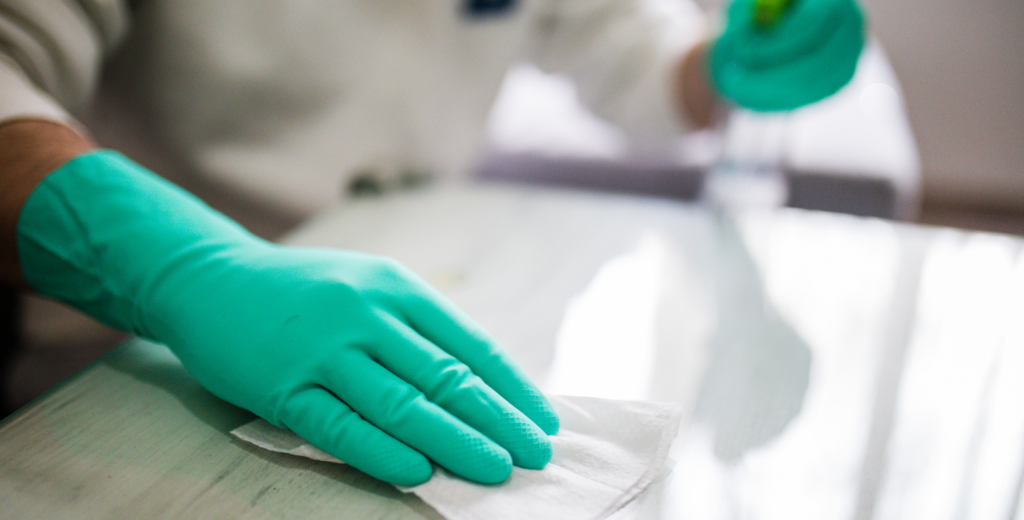
In order to avoid cross-contamination of food and the spread of dangerous germs and other microbes, prep tables need to be cleaned and sterilized between uses.
Cross-contamination can occur when various foods are prepared on the same prep table without it being cleaned and sanitized in between. The germs from the raw meat, for instance, can move to the veggies and perhaps result in foodborne illness if you prepare raw meat on a prep table and then use the same table to prepare fresh vegetables without cleaning it in between.
Any lingering germs or other potentially hazardous microbes on the prep table’s surface are eliminated by cleaning and sanitizing it after each usage. Eliminating any leftover bacteria on the table through sanitization helps to lower the danger of cross-contamination.
It’s crucial to remember that various food preparation surfaces could call for various cleaning and sanitizing procedures. Make careful to clean and sanitize each type of prep table according to the manufacturer’s instructions. In order to ensure food safety, food service organizations are frequently required to adhere to strict rules and regulations for cleaning and sanitizing prep tables.
How Long Does It Take To Completely Clean And Sanitize Dirty Tables At Restaurants?
A study from the University of Arizona found that it takes an average of 3 minutes to clean a dirty table at a restaurant. The study also found that the time taken to clean a dirty table depends on what kind of surface is used. For example, tables with laminate surfaces take less time to clean than those with wooden surfaces.
What to do after a table that has been sanitized for preparing food?
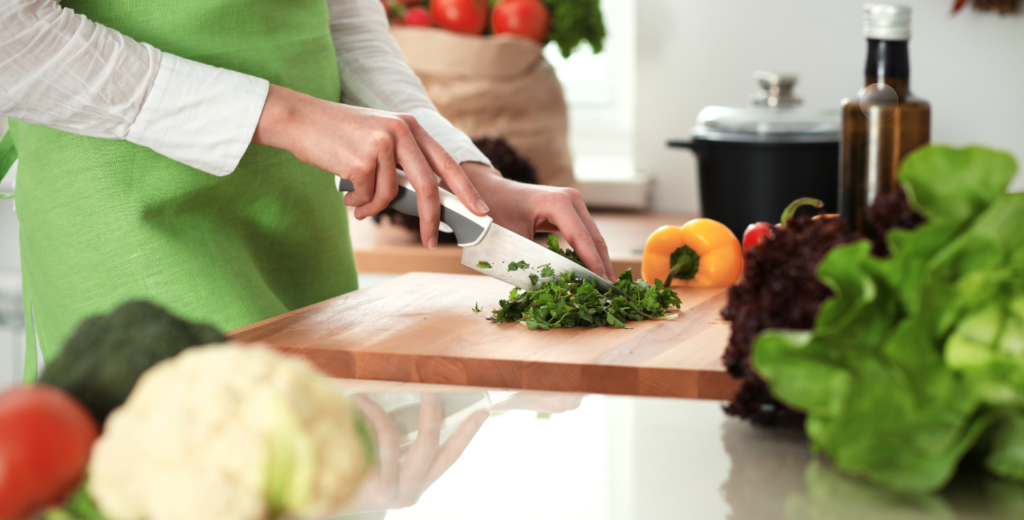
Sanitizing a table is the best way to ensure that it is safe for preparing food. After a table has been sanitized, it is important to understand what to do next. There are a few things you can do after you are done sanitizing the table.
The first step is to make sure that no bacteria is floating around. The easiest way to do this is to wipe down the table with an alcohol-based sanitizer. After the alcohol has dried, you should place a paper towel on top of the table. This will soak up any excess alcohol that may still be on the surface.
The next step is that you should wipe down the surface with a clean, damp paper towel. Then, make sure to dry the surface and sanitize the paper towels. The last thing you should do is check the temperature of the surface. There should be no noticeable difference in temperature. If there is a noticeable difference, you will need to restart the process.
What Are The Disadvantages Of Using Chemical Cleaners On Dirty Tables?
Chemical cleaners are not always the best option when it comes to cleaning tables. They can be harsh on the surface of the table, stripping away all of its protective coating. They can also be dangerous if you inhale them or get them into your eyes.
The disadvantages of using chemical cleaners on dirty tables are that they can strip away all of the protective coating from a table’s surface. Which leaves it vulnerable to scratches and other damage. Chemicals can also be dangerous if you inhale them or get them in your eyes.
Final Verdict
Choosing the best food-prep tables and linen supplies can be a daunting task. But it doesn’t have to be! Tables are a very important part of food hygiene because they are used for food preparation. They should be cleaned up after every use and sanitized before being put back into service. It is important that tables be cleaned up and sanitized after every use. This will help to prevent illness and keep the kitchen safe to work in. Without clean, sanitized tables, germs can build up and bacteria can spread making it hard to prepare food safely.

